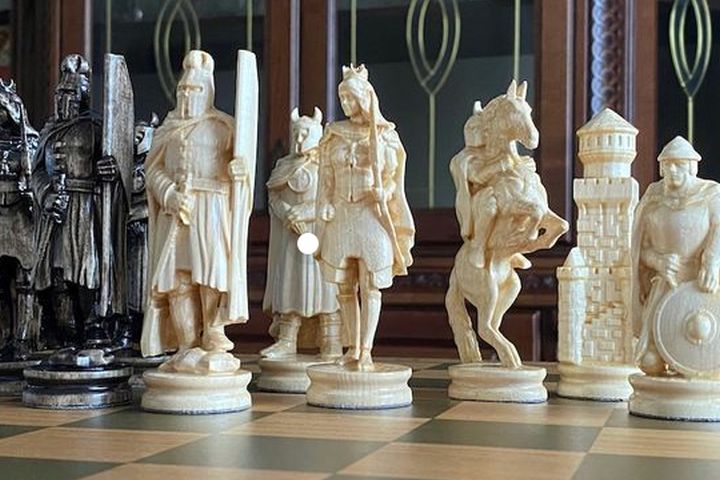


 Chess was invented in India during the sixth century. The game was called chaturanga, and when it migrated to Persia (around 700 AD), it was called chatrang, which was derived from the players exclaiming “shāh māt!” (“the king is helpless or dead”). And that, you will immediately recognize, is the origin of the modern term ‘checkmate’.
Chess was invented in India during the sixth century. The game was called chaturanga, and when it migrated to Persia (around 700 AD), it was called chatrang, which was derived from the players exclaiming “shāh māt!” (“the king is helpless or dead”). And that, you will immediately recognize, is the origin of the modern term ‘checkmate’.
If you want to know more about the migration of the game around the world, you should read Frank Jacobs' 2017 article How Chess Went Global. It includes this map, which you can click to enlarge.
Chaturanga is Sanskrit for “four-limbed”, referring to the four sections of the Indian army: infantry, cavalry, elephants and chariots. This is reflected more or less recognizably in the piece names. In his article How Did the Chess Pieces Get Their Names?, which appeared on April 21, 2023, Frank Jacobs meticulously traces the various piece names in different languages around the world. Here's a summary:
Pawns: the original Sanskrit padati, or “foot soldier”, came to us via the Latin pedester to modern French pion and English pawn. The Spanish term peon also means “farmer,” which is reflected in a number of Germanic languages, e.g. bonde in Danish, or Bauer in German.
Knight: in the original Chaturanga the piece was called asva, which is Sanskrit for “horse”. It reflects the unique ability of the piece to jump over other pieces. In this case the piece name tends to universally reflect this ability: cavallo in Spanish, springare in Swedish, Springer in German.
Rook: it was called ratha (“chariot”) in Sanskrit, rukh in Persian. In many European languages the piece is known as a tower or a castle – e.g. German Turm. English stuck with rook, but invented "to castle" for the king-and-rook move. Puzzlingly the piece is called “ship” (or “boat”) in some other languages, including Russian (lad’já) and Armenian (navak).
Bishop: this piece has the widest range of names. It started off as the Sanskrit hasti, for elephant, changed to the Persian pil, the French fil, and finally fou, which translates to “fool”. The Italians call it alfiere (“standard bearer”), the Germany call it Läufer (runner), the Serbians lovac (hunter), Slovak strelec (gunner). The Russians have stuck to the original “elephant” and call the piece slon. In his article Jacobs has very useful maps for each piece, like the following for the bishop (click to enlarge):

Queen: Originally this piece was the king’s “counselor” (mantri in Sanskrit). The Arabs used wazir (vizier), which became the French vierge (virgin), which became regina (queen) and dame (lady) in various languages.
King: the game’s central piece maintained its original title. Rajah is Sanskrit for “king.” The Russiand call it koról, the Germans König, Yiddish kinig.
Frank Jacobs' original article originally appeared on Big Think, home of the brightest minds and biggest ideas of all time.